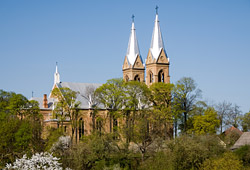The Church
The current brick church, built between 1896 and 1902, was designed by architect Ustinas Golinevičius and engineer Florijonas Vyganovskis. It boasts a rather eclectic composition showing both neo-gothic and roman elements, with twin towers, a rectangular floor plan, three naves, and an apse that is narrower and of lower height than the rest of the temple. Beside the two 56-meter towers on the facade, another 13 spires decorate the roof.
The gothic-style altars, made of oak, are from the Zaborskis workshops in Šiauliai. The main altarpiece, as in many churches, is free-standing. The renowned image of the Mother of God above the main altar is hidden, except during solemn celebrations, behind the early 20th century painting by the local artist R. Švoinickis “Christ teaching the children of Lithuania”. Local inhabitants refer to the painting as “Christ with people from Krekenava”, because the artist depicted residents of the town who were living at the time.
For the 50th anniversary of the church’s construction, the people of Krekenava commissioned J. Šalkauskienė, a niece of Bishop Kazimieras Paltarokas, to paint one more image for use as a cover of the miraculous painting of the Mother of God. In 1951, Bishop Paltarokas blessed the painting of Mary’s Assumption into Heaven.
Stained glass windows by Stasys Ušinskas embellish the presbytery. They depict St Casimir, Bishop M. Giedraitis, Archbishop J. Matulaitis and the Immaculate Conception. The 8 side windows contain symbolic stained glass representations by the artist Vytautas Švarlys. Inside the church above the main entrance is a stained glass monstrance created by Stasys Ušinskas in 1931. A large stained glass window of the Resurrection by Vytautas Švarlys was added in 1999 to commemorate the church’s 100-year jubilee.
The church’s organ, from Königsberg, is quite valuable. Among other significant artistic elements, there stand out the graceful pulpit which adorns the left side of the central nave by the first column, and the baptistery in the presbytery.








